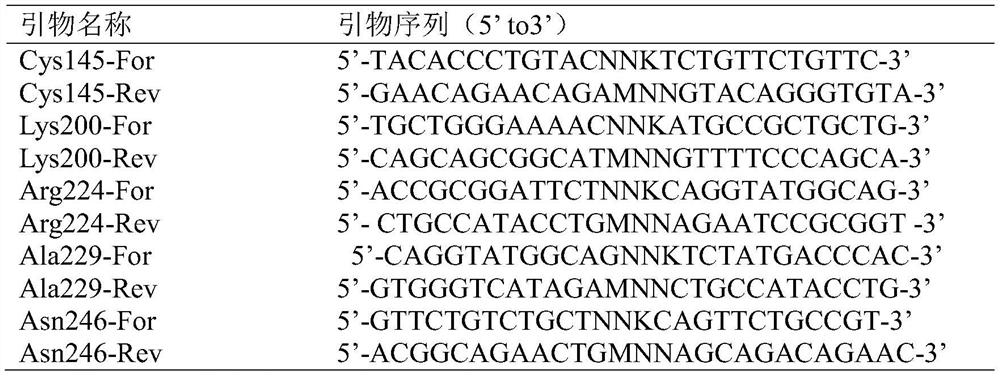A kind of nitrilase mutant with improved specificity of nitrile hydrolysis activity and application thereof
A kind of nitrilase, mutant technology, applied in the direction of hydrolase, application, enzyme, etc.
- Summary
- Abstract
- Description
- Claims
- Application Information
AI Technical Summary
Problems solved by technology
Method used
Image
Examples
Embodiment 1
[0023] Example 1 Construction of nitrilase mutants
[0024] 1. Construction of mutants
[0025] When rice nitrilase (OsNIT, GenBank accession number: AB027054, amino acid sequence SEQ ID NO. 1) catalyzes the reaction of phenylacetonitrile, the ratio of amide to carboxylic acid in the product is close to 1:1. Through bioinformatics analysis, the catalytic triplet was determined to be 196Cys-71Glu-162Lys, and then through rational design analysis, the 145th cysteine, the 200th lysine, the 224th arginine, and the 229th clan Site-directed saturation mutation of amino acid and asparagine at position 246 to construct a mutant with significantly improved reaction specificity, specifically:
[0026] The rice nitrilase (OsNIT, GenBank accession number: AB027054) gene (amino acid sequence SEQ ID NO.1, nucleotide sequence SEQ ID NO.2) was inserted between the BamH I and Hind III sites of the pET-28b vector to construct recombinant plasmids. Taking the recombinant plasmid as a template...
Embodiment 2
[0050] Example 2 Determination of reaction specificity and activity of nitrilase mutants C145N, K200R / R224W, A229P, N246V
[0051] The plasmid of the K200R mutant obtained in Example 1 was used as a template, and the R224W site-directed mutagenesis primer (Table 1 Lys200-For, Lys200-Rev) was used to carry out PCR amplification of the whole plasmid. The PCR system and reaction conditions were the same as in Step 1, and the method of Example 1 was adopted. A plasmid of mutant K200R / R224W (amino acid sequence shown in SEQ ID NO. 3) was constructed, and wet cells were prepared according to the method of Example 1.
[0052] The reaction system (20 mL) was composed of: 20 mL Tris-HCl buffer solution (50 mM, pH 8.0), 0.1 g of nitrilase mutant wet cells prepared by the method of Example 1, 0.9 mL of methanol, 100 mM of phenylacetonitrile (phenylacetonitrile first). soluble in methanol). The reaction solution was reacted at 30° C. and 180 rpm for 30 min. Sampling 1 mL, adding 20 μL 2...
Embodiment 3
[0057] Example 3 Construction of the nitrilase multiple mutant K200R / R224W / A229P.
[0058] The single-point mutation results of Example 1 were analyzed, and it was found that the 200th, 224th, and 229th site mutations could change the reaction specificity to make it tend to generate carboxylic acid, and the hydrolysis activity was better preserved or improved, The hydration activity was inhibited, and the mutant K200R / R224W / A229P was obtained by superimposing mutations, specifically:
[0059] Take the K200R / R224W mutant plasmid constructed in Example 2 as a template, adopt 229 site primers (Table 1Ala229-For, Ala229-Rev) to carry out PCR amplification of the whole plasmid, PCR system and reaction conditions are the same as step 1, using Example 1 Methods A plasmid containing nitrilase mutant K200R / R224W / A229P was constructed.
[0060] According to the method of Example 1, wet bacterial cells capable of measuring the ratio of carboxylic acid and viability were obtained by cult...
PUM
 Login to View More
Login to View More Abstract
Description
Claims
Application Information
 Login to View More
Login to View More - R&D
- Intellectual Property
- Life Sciences
- Materials
- Tech Scout
- Unparalleled Data Quality
- Higher Quality Content
- 60% Fewer Hallucinations
Browse by: Latest US Patents, China's latest patents, Technical Efficacy Thesaurus, Application Domain, Technology Topic, Popular Technical Reports.
© 2025 PatSnap. All rights reserved.Legal|Privacy policy|Modern Slavery Act Transparency Statement|Sitemap|About US| Contact US: help@patsnap.com



